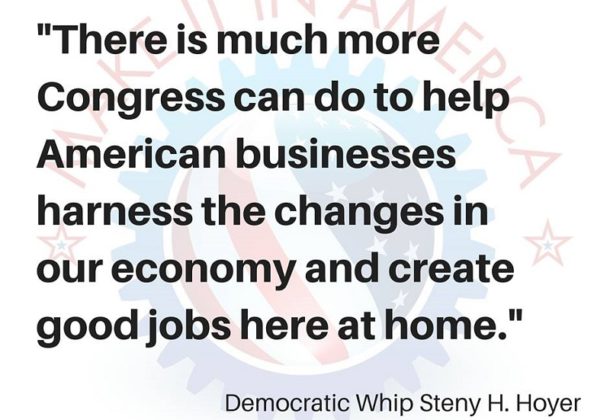Hoyer Unveils Updates to Make It In America Plan

House Democratic Whip Steny H. Hoyer (MD) and House Democrats created the Make It In America plan six years ago to encourage private sector job creation in the US. On June 13,2016 Congressman Hoyer unveiled an updated Make It In America plan to address the country’s economic challenges and opportunities.
In 2015, House Democrats, including Mr. Hoyer, hosted hearings titled “Make It In America: What’s Next?”
The hearings explored how the economy has, and hasn’t, changed since the plan was first launched, and what families and businesses need to succeed in today’s economy. During the hearings, 77 House Democrats heard testimony from innovators, entrepreneurs, economists, members of Congress, and others about needed updates to keep Make It In America plans relevant to today’s challenges and take advantage of new opportunities. The updated Make It In America plan builds on the ideas explored during the hearings.
Make It In America Over the Past Six Years
Launched on July 22, 2010, the Make It In America jobs plan was created when the US economy was recovering from the worst economic crisis since the Great Depression:
- The unemployment rate was 9.4 percent, having more than doubled since the recession began in 2007.
- Of those unemployed at the time, nearly half – 45 percent – had gone without work for more than 6 months.
- The Dow Jones Industrial Average closed at 10,322 – still down more than a quarter from its pre-recession high.
- Credit card delinquencies were peaking, with more than 13 percent of card balances over 90 days overdue.
The Make It In America plan was focused on the goal of creating the best conditions for American businesses to manufacture their products, innovate, and create jobs right here at home. Each Congress, the Make It In America plan has been updated with new legislation and ideas to strengthen the economy.
Since 2010, 17 Make It In America bills have been signed into law, including legislation to cut taxes and provide loans for small businesses, speed up the patent process, train skilled workers, and end tax loopholes that encourage companies to ship jobs overseas.
Today, the economy is very different than it was in 2010. A key part of the “Make It In America: What’s Next?” hearing series was to discuss bright spots in the economy and how to build on those successes, and to look at the new challenges facing the economy and explore ways to address them.
Signs of Recovery:
- The unemployment rate is 4.7 percent.
- May 2016 marked the 75th consecutive month of private-sector job growth.
- 2015 was America’s best year of job growth since 1999.
- Manufacturing employment is up 6 percent since the July 2010 launch.
- The Dow Jones Industrial Average closed at 17,985 on June 9, 2016, which represents a 57 percent increase from when the Make It In America plan was launched in 2010.
New Challenges:
- The benefits of recovery have not been felt equally. For example: The unemployment rate for African Americans is 8.2 percent, which is around the same level the broader population experienced during the worst of the recession. [BLS] Hispanic Americans face an unemployment rate of 5.6 percent.
- Real wages fell sharply during the recession, and for at least 70 percent of the workforce, wages have yet to return to pre-recession levels.
- There are more than half a million unfilled jobs in information technology across all sectors of the economy.
- Women and minorities are underrepresented in many STEM fields — despite the fact that these demographic groups comprise more than two-thirds of college students.
- New business startups, booming in parts of the West and Southwest, have lagged in many Northern and Midwestern cities.
To Make It In America in Today’s Economy, We Must:
To reflect the changing economy, the Make It In America plan has been updated to tackle the issues Americans face in today’s economy:
Expand Entrepreneurship and Innovation
- Promote entrepreneurship through access to Maker Spaces and Fab Labs
- Increase access to capital for entrepreneurs, with protections for investors, so that start-up businesses can get off the ground.◦Facilitate the growth of the on-demand economy while ensuring strong labor protections.
- Provide tax incentives and reduce regulatory burdens to incentivize entrepreneurship and give start-up businesses a stronger chance at success.
Close the Skills Gap
- Promote partnerships between educational institutions and businesses, including through apprenticeships, to build a workforce that has the skills needed for today’s economy. ◦Increase resources for job training & retraining programs.
- Invest in STEAM (science, technology, engineering, the arts, mathematics) education at every level.
Build a 21st-Century Infrastructure
- Invest in a modern transportation infrastructure – highways, railways, ports, airports – to connect companies with their workers and improve their ability to access markets.
- Invest in local public infrastructure, including water and energy delivery systems, which can attract or deter companies from staying in a location.
- Invest in modern technology infrastructure, including broadband, which is critical to ensuring businesses have access to the growing majority of their customers.
Break Down Barriers to Manufacturing in the US
- Support businesses during the scale-up phase so that it makes financial sense to make their products here in the US.
- Continue to support manufacturing networks and regional programs that increase U.S. competitiveness.
- Increase exposure to manufacturing & manufacturing concepts at all levels of education to build the next generation of manufacturers.
Click here to read the PDF.
Follow Congressman Hoyer on Facebook and Twitter.
For more information about House Democratic Whip Steny H. Hoyer, visit his Leader member page.






















